Railroad Rules, Signalling, Operations:
Direct Traffic Control
Contents
Introduction
The DTC Block
Movement Authority
Directional
Authority
Restricted
Authority
Work and Time
Authority
Multiple DTC Authorities
in the Same DTC Block
Changing Authority
Releasing DTC
Block Authority
A DTC Example
Introduction
Direct Traffic Control (DTC) is a verbal authorization system defined
by the General Code of Operation Rules (GCOR), used to authorize
trains to occupy Main Tracks. DTC can be used as a stand-alone safety system
in unsignaled territories, or can be supplemented with Automatic Block
Signaling (ABS) to increase flexibility and traffic capacity. DTC is as
far as I know used by Union Pacific and CSX, on the former Southern Pacific,
Chicago and North Western and Seaboard Coast Line. Direct Traffic Control
on the former Chicago and North Western lines was quickly replaced by Track
Warrant Control after the Union Pacific takeover, as TWC is the systems
used by Union Pacific. If is not unlikely that DTC will also disappear
from the former Southern Pacific lines within the next few years. TWC is
used on the other western railroads and is a more flexible - but also more
complex - system.
Direct Traffic Control divides the line into fixed DTC Blocks. Trains
are authorized to occupy specific DTC Blocks. DTC rules specify fixed wording
for messages concerning the grant or release of DTC Blocks. The train crews
must keep a written note of the DTC Blocks their train is authorized to
occupy. The train releases the DTC Block Authorities after it has cleared
the DTC Blocks.
The DTC Block
A DTC line is divided into fixed DTC Blocks. The DTC Blocks are named,
typically after a Station at one end of the DTC Block. The extension of
each DTC Block is defined in the Timetable and is also marked by lineside
signs.
A line with regularly spaced Sidings will usually be divided into DTC
Blocks extending from one Siding to another. At some locations, however,
the line between two Sidings has been subdivided into 2 or more DTC Blocks.
Below is shown an example of a DTC line:

The Stations Anna and Danby have a Siding for meets. Bolo is just an
intermediate Station while Coyote Jct is the junction of another line.
DTC Block boundaries at Anna and Danby are at one end of the siding,
in this example the east end. Placing the boundary at one end of the Siding
helps speed up certain meets, as will be shown later. The DTC Block boundary
at Bolo it at the Station sign. Many stations like Bolo have once had a
Siding, and therefore the DTC Block boundary may still be where it was
in the days of the Siding. At Coyote Jct it is most practical to place
the DTC Block boundary so as to facilitate trains going on or off the branch
without occupying the DTC Block to the West. In the example the DTC Blocks
are named after the Stations at the east end of the Blocks, thus defining
the DTC Blocks "Anna", "Bolo", "Coyote", "Danby" and "Eve".
Movement Authority
A DTC Block Authority is issued in the following steps, usually using radio:
-
The dispatcher reads the DTC Block Authority to a crew member on the train,
using a prescribed wording (see the following sections). The train crew
member in control of the train (i.e. usually the engineer) is not allowed
to receive DTC Block Authority.
-
The train crew member then repeats the information to the dispatcher.
-
The dispatcher checks the information and, if correct, says "<Train>,
that is correct.".
A DTC Block Authority cannot not be considered valid until the dispatcher
says "<Train>, that is correct.".
Directional Authority
Directional Authority authorizes a train to occupy one or more DTC Blocks,
moving in a specified direction. A train having been issued a Directional
Authority is not allowed to move backwards in the DTC Block. But since
a DTC Block is only the Main Track, a train may set back into a spur or
siding.
To illustrate how a Directional Authority is issued, we'll use the example
below. A train (7241 East) has Authority in the DTC Block Anna only, and
the Dispatcher is to issue Directional Authority to DTC Blocks ahead:

To give Directional Authority in one DTC Block, the following wording
is used:
-
Dispatcher: "7241 East, with Engineer Jones at 8:10 AM, you are authorized
to proceed Eastward in one block, Bolo".
-
Crew Member: "7241 East, with Engineer Jones at 8:10 AM, I am authorized
to proceed Eastward in one block, Bolo".
-
Dispatcher: "7241 East, that is correct".
After receiving "That is correct", 7241 has Directional Authority in DTC
Block Bolo as well:

To give Directional Authority in two DTC Block, the following wording
is used:
-
Dispatcher: "7241 East, with Engineer Jones at 8:10 AM, you are authorized
to proceed Eastward in two blocks, Bolo and Coyote".
-
Crew Member: "7241 East, with Engineer Jones at 8:10 AM, I am authorized
to proceed Eastward in two blocks, Bolo and Coyote".
-
Dispatcher: "7241 East, that is correct":

To give Directional Authority in more than two DTC Blocks, the following
wording is used:
-
Dispatcher: "7241 East, with Engineer Jones at 8:10 AM, you are authorized
to proceed Eastward in three blocks, Bolo through Danby".
-
Crew Member: "7241 East, with Engineer Jones at 8:10 AM, I am authorized
to proceed Eastward in three blocks, Bolo through Danby".
-
Dispatcher: "7241 East, that is correct".

Restricted Authority
In dark territory a train may be issued Restricted Authority to follow
behind a train granted Directional Authority to that same DTC Block. Movement
must be made at Restricted Speed. Restricted Authority may only be granted
one train in a DTC Block. Restricted Authority may only be granted after
the Dispatcher is has assertained him/herself that the train ahead has
passed the point where the train given Restricted Authority will enter
the DTC Block. When the train ahead has released the DTC Block in question,
the requirement for Restricted Speed may be canceled, converting the Restricted
Authority to a Directional Authority.
Restricted Authority is typically used to allow a train to pull out
of a Siding after being overtaken. If the train has to line a switch back
behind itself, it can pull out on the Main on the Restricted Authority.
In most cases the train ahead has cleared the DTC Block before the second
train is ready to depart.

To give Restricted Authority in one DTC Block, the following wording
is used:
-
Dispatcher: "7241 East, with Engineer Jones at 8:10 AM, you are authorized
to proceed Eastward at restricted speed following 8543 East in one block,
Bolo".
-
Crew Member: "7241 East, with Engineer Jones at 8:10 AM, I am authorized
to proceed Eastward at restricted speed following 8543 East in one block,
Bolo".
-
Dispatcher: "7241 East, that is correct".
Canceling the requirement for Restricted Speed is done using the wording:
-
Dispatcher: "7241 East, with Engineer Jones at 8:30 AM, authority in the
Bolo block is no longer restricted".
-
Crew Member: "7241 East, with Engineer Jones at 8:30 AM, authority in the
Bolo block is no longer restricted".
-
Dispatcher: "7241 East, that is correct".
After receiving "That is correct", 7241 has Directional Authority in DTC
Block Bolo as well.
Work and Time Authority
Work and Time Authority permits a train to occupy the DTC Block(s) and
move in either direction. Several trains may be present in the DTC Block
under Work and Time Authority, in which case movements must be at Restricted
Speed. A second train may not be issued Work and Time Authority to a DTC
Block before the train already issued a Work and Time Authority is informed
that the DTC Block will be jointly occupied. As the name suggests, a Work
and Time Authority is time limited, i.e. the train must have cleared the
DTC Block(s) before that time expires. The DTC Block(s) cannot, however,
be considered clear until they are released by the train.
Work and Time is issued by the dispatcher using the wording:
-
Dispatcher: "7241 East, with Engineer Jones, I am granting you Work and
Time in one block, Bolo, until 10:10 AM".
-
Crew Member: "7241 East, with Engineer Jones, I am granted Work and Time
in one block, Bolo, until 10:10 AM".
-
Dispatcher: "7241 East, that is correct".
Work and Time may be granted in several DTC Blocks, using similar wordings.
Work and Time may be issued only if:
|
|
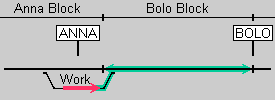 |
-
Or (in ABS territory only) the DTC Work and Time Authority will
not take effect before the arrival of a train running on Directional Authority
in the DTC Block.
|
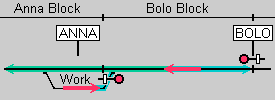 |
-
Or the DTC Block has been allocated under Work and Time Authority
to another train which is informed that the DTC Block will be jointly occupied.
|
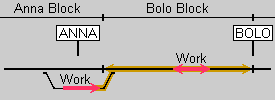 |
Multiple DTC Authorities in the Same
DTC Block
Only one DTC Authority may be issued issued in the same DTC Block, except
in the following cases:
-
In ABS territory, multiple Directional Authorities may overlap
in
the same direction, as the ABS will protect following trains from each
other.
|
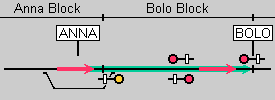 |
-
In Dark Territory, as specified for Restricted Authority, to follow
another train still in the same DTC Block. After the first train releases
the DTC Block, the Dispatcher may upgrade the Authority to a Directional
Authority.
|
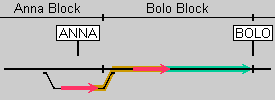 |
-
At meets, when Directional Authority will not take effect before arrival
of an opposing train. The DTC Authority must include the words "...after
the arrival of <train>".
|
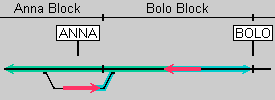 |
-
Under Work and Time Authority when trains are instructed to move at Restricted
Speed.
|
 |
Changing Authority
If it becomes necessary to change the DTC Block Authority previously granted
to a train, a new Authority is granted in the specified manner. After the
"That is correct" message, the previous Authority to the DTC Block(s) in
question becomes void.
Releasing DTC Block Authority
When a train has cleared a DTC Block, the DTC Block must immediately be
released to the Dispatcher, unless the Dispatcher has specified that immediate
release is not necessary.
A train may release a DTC Block only when the entire train has cleared
the DTC Block. If a train clears the DTC Block by entering a Secondary
Track, the switch must be lined back to the Main Track before releasing
the DTC Block.
To release one DTC Block, the following wording is used:
-
Crew Member: "7241 East, with Engineer Jones, I am releasing one block,
Bolo".
-
Dispatcher: "7241 East, with Engineer Jones, you are releasing one block,
Bolo".
-
Crew Member: "Train dispatcher, that is correct".
Similar wordings are used for the release of more than one DTC Block, following
the pattern for issuing Authorities.
A DTC Example
The following is an example of how Direct Traffic Control may be used to
control an unsignaled, single track, line. The example line is similar
to what has been shown above, with the two sidings Anna and Danby, though
Danby is now controlled by CTC. In between are the stations Bolo and Coyote
Jct. The timetable text would read something like:
DTC in effect between <Somewhere West> and Danby.
CTC in effect between west switch Danby and <Somewhere East>.
This means that the siding at Danby is under CTC, while the siding at
Anna has manual switches.

Two trains are to meet at Anna. The trains will be called 585 East
(Eastbound) and 5032 West (Westbound). 585 East will be arriving
first to the meet and is to take Siding. Since the switches are hand-thrown,
the 585 East has to line the switch back after pulling into the siding.
This means leaving the Conductor behind to line the switch back, after
which he/she will have to walk up to the locomotive.
The DTC Authority for 585 East, from a DTC Block somewhere west could
read:
-
"585 East, with Engineer Smith at 1.25 PM, you are authorized to proceed
eastward in four blocks, Somewhereelsewest through Anna".
585 East would also be instructed to take siding at Anna and, since there's
little other traffic, that it need not release its DTC Blocks before clearing
the Anna Block.
5032 West is somewhere beyond Danby and has not yet been issued a DTC
Authority to go further than Danby. Only the signal into the main track
at Danby has been cleared but even if the signals were clear through Danby,
5032 West would not be permitted to depart Danby without a DTC Authority:

As 5032 West approaches Danby it is time to issue a DTC Authority. Since
5032 West is an ordinary train and no other trains are ahead, 5032 West
is issued a Directional Authority to the meet at Anna:
-
"5032 West with Engineer Jones at 1:34 PM, you are authorized to proceed
westward in three blocks, Danby through Bolo".
5032 West is also instructed that it need not release its DTC Blocks before
clearing the Bolo Block. When the DTC Authority has been issued, the dispatcher
clears the signals out of Danby:

585 East has how arrived at the west switch at Anna and prepares to
head into the siding. 5032 West is approaching Danby:

585 East is now in the siding and releases its DTC Blocks:
-
"585 East, with Engineer Smith at 2:03 PM, I am releasing four blocks,
Somewhereelsewest through Anna":

With 585 East in the clear, 5032 West can be permitted to continue past
Anna. The dispatcher issues a further DTC Authority to 5032 West:
-
"5032 West with Engineer Jones at 2:05 PM, you are authorized to proceed
westward in four blocks, Anna through Somewhereelsewest".
5032 West now has DTC Authority in all DTC Blocks between Danby and Somewehreelsewest.
Since other traffic doesn't require the DTC Blocks behind 5032 West, there
is no reason to release them one by one.
The dispatcher also issues a new DTC Authority for 585 East:
-
"585 East, with Engineer Smith at 2:07 PM, you are authorized to proceed
eastward in three blocks, Bolo through Danby after arrival of 5032 West".
"...after arrival of 5032 West" suspends the DTC Authority until 5032 West
has cleared the east switch at Anna:

As soon as 5032 West clears the east switch at Anna, 585 East's Directional
Authority comes in effect. 5032 West releases the traversed DTC Blocks:
-
"5032 West with Engineer Jones at 2:21 PM, I am releasing three blocks,
Danby through Bolo".
585 East's Directional Authority comes in effect even before 5032 West
has released the DTC Blocks to the Dispatcher.

After 585 East has pulled out of the Siding, our poor conductor will
once more have to line the switch back and walk up to the locomotive before
585 East can get on the move again. The dispatcher has set up a new meet
for 585 East at Danby, but this time all controlled by CTC:

[Back]
[Home]
Text, Images and HTML: Carsten S. Lundsten.





















